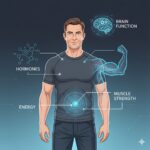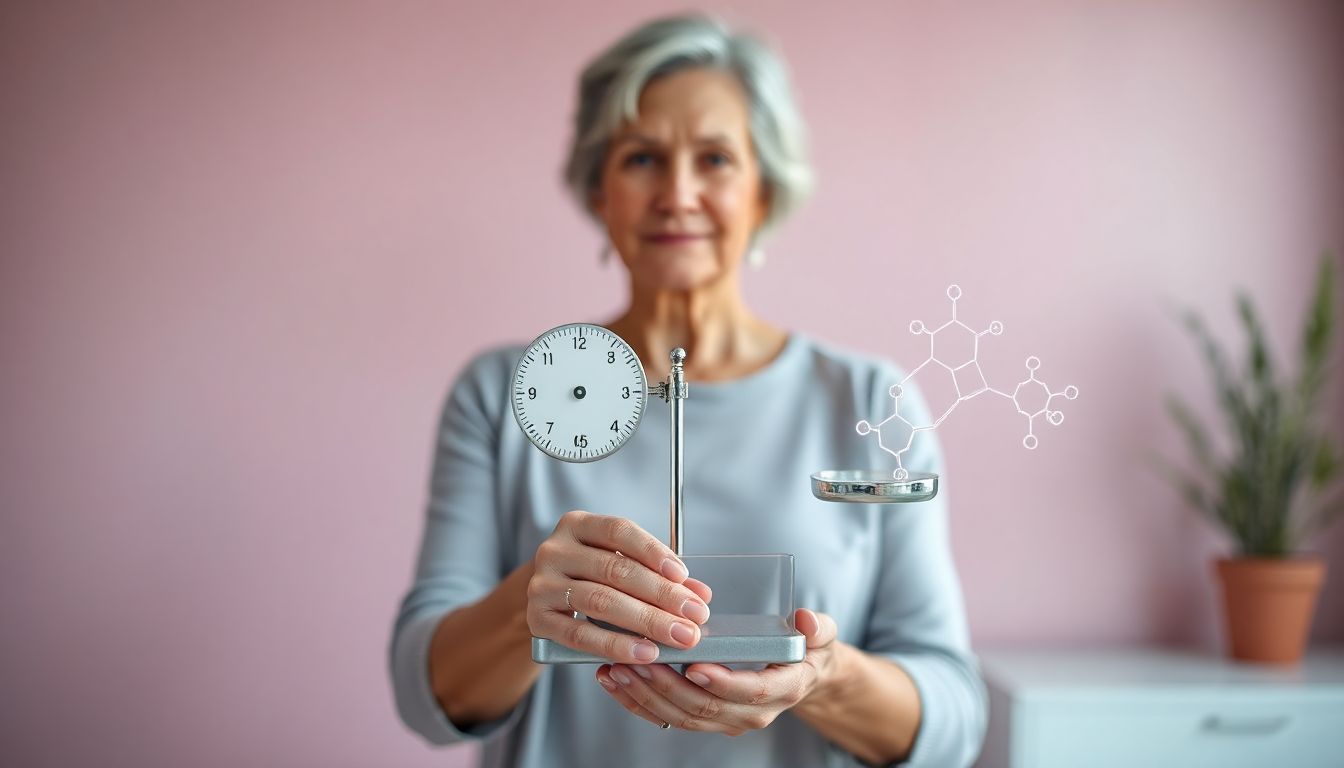🌸 The Two Faces of Estrogen Imbalance
During menopause, hormones fluctuate like waves — and estrogen often steals the spotlight.
Some women experience too much estrogen relative to progesterone (estrogen dominance), while others feel the effects of too little estrogen (estrogen deficiency).
Understanding which side of the scale you’re on can help you choose the right diet, lifestyle, and supplement strategy — and finally start feeling like yourself again.
⚖️ 1. What Exactly Is Estrogen?
Estrogen isn’t one hormone — it’s a family of three:
- Estradiol: the strongest form, dominant before menopause.
- Estrone: becomes dominant after menopause.
- Estriol: the weakest, often linked to vaginal and urinary health.
Estrogen plays a vital role in:
- Regulating menstrual cycles
- Supporting bone and heart health
- Maintaining mood stability
- Promoting healthy skin, hair, and vaginal tissue
When its levels fluctuate or fall, you’ll feel it — physically and emotionally.
📎 Learn more: What Really Happens to Your Hormones During Menopause
🔺 2. What Is Estrogen Dominance?
Estrogen dominance occurs when estrogen levels are high relative to progesterone — even if estrogen itself isn’t elevated.
This imbalance is most common during perimenopause, when progesterone declines faster than estrogen.
Common Symptoms:
- Bloating and water retention
- Breast tenderness
- Heavy or irregular periods
- Irritability or anxiety
- Weight gain (especially hips and thighs)
- PMS-like mood swings
Underlying Causes:
- Chronic stress (lowers progesterone)
- Poor liver detoxification (estrogen not cleared efficiently)
- Processed food and alcohol (increase estrogen load)
- Synthetic estrogens from plastics and cosmetics
📎 Explore: How Stress and Cortisol Worsen Menopause Symptoms
🔻 3. What Is Estrogen Deficiency?
Estrogen deficiency typically occurs during menopause and postmenopause, when estrogen production drops significantly.
Common Symptoms:
- Hot flashes and night sweats
- Vaginal dryness and discomfort
- Insomnia
- Low mood and depression
- Joint stiffness
- Thinner skin and hair
Without estrogen’s protective effects, the body experiences a cascade of changes — affecting bones, heart, and even brain chemistry.
📎 Related reading: The Complete Guide to Managing Menopause Naturally
🧬 4. The Delicate Balance Between Estrogen and Progesterone
Estrogen and progesterone are like dance partners — each keeps the other in rhythm.
When progesterone drops faster than estrogen, the imbalance can trigger chaos.
| Scenario | Estrogen Level | Progesterone Level | Typical Phase | Symptoms |
|---|---|---|---|---|
| Dominance | High | Low | Perimenopause | PMS, bloating, anxiety |
| Deficiency | Low | Low | Menopause/Postmenopause | Hot flashes, dryness, fatigue |
The goal isn’t to “boost estrogen” blindly — it’s to restore harmony between both hormones.
📎 Read next: Natural Ways to Rebalance Hormones Without HRT
Comparing Estrogen Dominance vs. Deficiency During Menopause
“Here’s a quick comparison chart to help you identify which hormonal pattern matches your current symptoms — and which natural strategies can help rebalance them.”
🧩 Comparison Table: Estrogen Dominance vs. Deficiency
| Feature | 🔺 Estrogen Dominance | 🔻 Estrogen Deficiency |
|---|---|---|
| Typical Phase | Perimenopause (Progesterone drops faster than Estrogen) | Menopause / Postmenopause (Estrogen production drops significantly) |
| Hormonal Pattern | Estrogen is high relative to Progesterone (imbalance) | Estrogen is low overall (deficiency) |
| Key Symptoms | Bloating, Anxiety, Breast tenderness, Heavy/irregular periods, Weight gain (hips/thighs), PMS-like mood swings | Hot flashes, Night sweats, Vaginal dryness, Insomnia, Low mood, Joint stiffness, Thinner skin/hair |
| Underlying Causes | Chronic stress (lowers Progesterone), Poor liver detoxification, Processed foods/alcohol, Environmental synthetic estrogens (xenoestrogens) | Natural ovarian decline, Surgical removal of ovaries |
| Natural Strategies | Focus: Clearing & metabolizing excess estrogen | Focus: Phytoestrogen support & tissue comfort |
| Nutrition | 🥗 Eat cruciferous vegetables (broccoli, kale) for DIM — helps clear excess estrogen. High-fiber diet. | 🍓 Eat phytoestrogen-rich foods (flaxseed, soy, lentils) to gently mimic estrogen. |
| Detox / Lifestyle | Improve liver and gut health. Reduce exposure to xenoestrogens (plastics, cosmetics). | Use vaginal moisturizers or lubricants. Do weight-bearing exercise for bone protection. |
| Hormone Support | Reduce cortisol through stress management (yoga, nature walks). | Use herbs like Red Clover and Black Cohosh to support estrogen receptors and reduce hot flashes. |
🌿 5. Natural Ways to Rebalance Estrogen
You can support hormonal equilibrium gently and safely through lifestyle, nutrition, and targeted supplementation.
🥗 Eat for Detoxification & Balance
- Cruciferous vegetables (broccoli, kale, cauliflower): contain DIM, which helps clear excess estrogen.
- Flaxseed: contains lignans that balance estrogen metabolism.
- Leafy greens and berries: rich in antioxidants that protect cells from oxidative stress.
- Avoid refined sugar, alcohol, and trans fats — they increase estrogen dominance.
📎 Learn more: The Menopause Diet Plan: What to Eat and What to Avoid
🧘♀️ Reduce Stress
High cortisol steals progesterone, worsening estrogen dominance.
Combat stress through:
- Deep breathing
- Yoga or tai chi
- Journaling
- Spending time in nature
📎 Explore: Mindfulness and Meditation for Menopause Relief
💤 Prioritize Restorative Sleep
Poor sleep disrupts hormone detoxification and metabolism.
Create a cool, dark sleep environment and avoid caffeine after noon.
📎 Related: How to Sleep Better Through Menopause
💊 Support With the Right Supplements
Certain herbal extracts naturally assist estrogen balance:
- Red Clover: provides phytoestrogens for estrogen deficiency.
- Black Cohosh: supports estrogen receptor sensitivity.
- Sage Extract: reduces night sweats and hot flashes.
- Magnesium: relaxes nerves and aids progesterone production.
🌺 Featured Natural Support: Menovelle™
Menovelle™ blends these clinically supported ingredients into one complete formula for hormone harmony.
Women report noticeable relief from hot flashes, improved sleep, and emotional balance within weeks.
👉 Learn more about Menovelle™ here!
(Affiliate disclosure: We may receive a small commission at no cost to you.)
🎥 Watch the Short Video Presentation
Scientists have discovered a simple daily method that helps balance hormones naturally — without synthetic treatments.
👉 Watch here or Tap “Learn More Now” Button below.
🩷 6. When to Seek Professional Support
If you’re unsure whether your symptoms point to estrogen dominance or deficiency, ask your doctor about hormone testing — especially if you experience:
- Persistent irregular bleeding
- Severe mood swings
- Hot flashes affecting daily function
- Unexplained weight gain
- Low libido or vaginal pain
A functional medicine or hormone-specialist GP can tailor a plan — combining natural therapies, nutrition, and sometimes HRT if needed.
📎 Next read: How Stress and Cortisol Worsen Menopause Symptoms
💬 FAQs About Estrogen Balance
- Can you have estrogen dominance and deficiency at the same time?
Yes — many women experience fluctuating cycles where estrogen is high one week and low the next. - Is estrogen dominance common in perimenopause?
Very. It’s often the first imbalance before menopause fully begins. - What are natural estrogen foods?
Soy, flaxseeds, lentils, chickpeas, and sesame seeds. - How long does estrogen dominance last?
Usually through late 40s; balance often returns after menopause. - Does exercise help estrogen balance?
Yes — it reduces insulin resistance and clears excess estrogen. - Can low estrogen cause depression?
Yes, estrogen affects serotonin, the “happy hormone.” - Is it safe to take phytoestrogens daily?
Yes, in food and supplement form — they act as mild regulators, not boosters. - Can estrogen dominance cause weight gain?
Yes, especially in the hips, thighs, and lower abdomen. - How do I know which imbalance I have?
Track your symptoms or get a hormone test from a healthcare provider. - What’s the best way to balance estrogen naturally?
Focus on nutrition, stress reduction, sleep, and herbal support like Menovelle™.
🌿 Conclusion: Balance, Not Extremes
Menopause isn’t about “too much” or “too little” — it’s about finding your personal equilibrium.
Once you understand your hormonal pattern, you can use food, movement, rest, and natural supplements to restore harmony.
With knowledge comes peace — and with balance, vitality returns.
“You don’t need to fight your hormones. You just need to help them find their rhythm again.”
👉 Read the full guide: The Complete Guide to Managing Menopause Naturally










